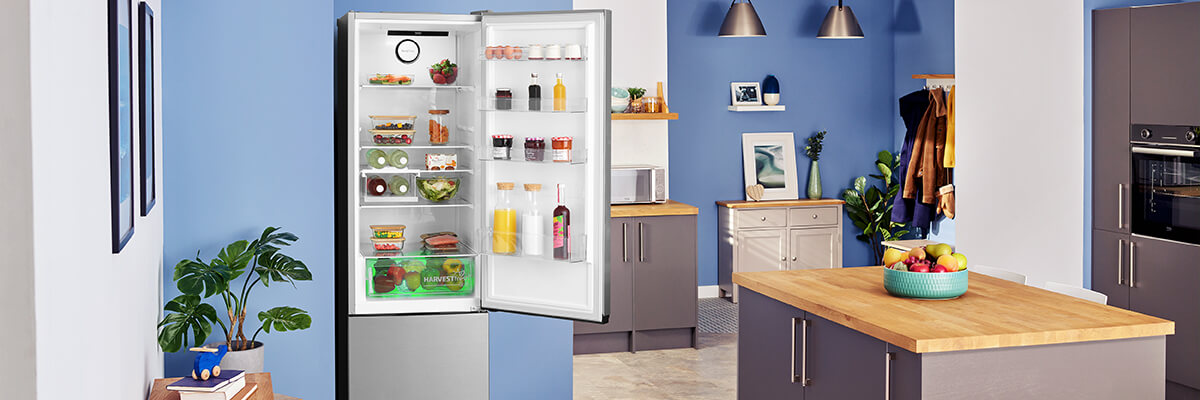How Much Does a Fridge Freezer Cost to Run?
In today's world, where energy efficiency and cost-saving are increasingly important, understanding the running costs of household appliances like fridge freezers is crucial. These costs can vary significantly based on several factors, including the appliance's energy efficiency, usage patterns, and model type.
At Beko, we offer a wide range of fridge freezers to choose from and aim to help you understand their running costs. In this guide, we will explore these factors and provide practical tips on reducing energy consumption and, consequently, your electricity bills.

Factors affecting fridge freezer running costs
Energy efficiency
One of the primary factors influencing the running cost of a fridge freezer is its energy efficiency. Modern fridge freezers come with energy ratings that typically range from A to G in the UK, with A being the most energy-efficient. These ratings are part of the European Union energy label scheme, which helps consumers compare the energy consumption of different appliances.
A-rated fridge freezers are the most energy-efficient, using significantly less energy compared to lower-rated models. While they might have a higher upfront cost, the savings on electricity bills can be substantial over the appliance's lifespan.
Older fridge freezer models that are several years old may not be as energy-efficient. Technological advancements mean newer models are designed to consume less power while offering better performance.
Amount of use
How you use your fridge freezer also impacts its running costs. Several aspects of usage can influence energy consumption:
- Frequency of opening doors: Every time you open the fridge or freezer door, warm air enters, and the appliance has to work harder to cool down again. Minimising the number of times you open the doors can save energy.
- Storage practices: Keeping your fridge and freezer well-stocked can help maintain the internal temperature. However, overloading it can block vents and reduce efficiency. Ensuring proper air circulation is key to optimal performance.
- Temperature settings: Setting your fridge and freezer to unnecessarily low temperatures increases energy consumption. The recommended temperatures are around 3-5°C for the fridge and -18°C for the freezer.
Model types
The type and size of the fridge freezer you own also play a role in determining running costs.
- Size: Larger fridge freezers generally consume more electricity than smaller ones, as they have more space to cool. When purchasing a new appliance, it’s important to choose a size that fits your needs to avoid unnecessary energy usage, read our guide to help you pick the right fridge freezer size for your home.
- Type: Different types of fridge freezers, such as side-by-side, top-freezer, or bottom-freezer models, can have different energy consumption rates. For instance, top-freezer models are often more energy-efficient compared to side-by-side models due to their design.
Tips to Reduce Energy Consumption
Reducing the running costs of your fridge freezer involves both proper usage and maintenance practices. Here are some tips to help you lower energy consumption:
Regular maintenance
- Clean the coils: The condenser coils, located at the back of your refrigerator near the floor, can accumulate dust and dirt. This build-up makes your fridge freezer work harder. Cleaning the coils at least twice a year helps to maintain efficiency. For American Style Refrigerators, please note that the compressor and condenser may be hidden behind a rear cover, so these components might not be visible without removing the cover.
- Check seals and gaskets: Ensure that the door seals are tight and not damaged. Faulty seals allow warm air to enter, increasing energy consumption.
- Defrost regularly: If you have a manual defrost model, make sure to defrost it regularly. Ice build-up can make the appliance less efficient.
Optimal placement
Avoiding heat sources is an important factor when placing your fridge freezer in your home. Place your fridge freezer away from heat sources like ovens, dishwashers, or direct sunlight. Excess heat can cause the appliance to use more energy to stay cool.
Proper ventilation is also crucial. Ensure there is enough space around the fridge freezer for air to circulate. This helps dissipate heat generated by the appliance and improves efficiency.
Smart usage habits
- Organise efficiently: Keep frequently used items at the front of the fridge to minimise the time the door is open. Use containers to organise food and keep the fridge tidy.
- Cool food before storing: Avoid placing hot food directly into the fridge or freezer. Let it cool to room temperature first to reduce the load on the appliance.
- Fill it up: A full fridge retains cold better than an empty one. If you don’t have enough food, you can use water bottles to fill up space.
Understanding the factors that affect the running costs of a fridge freezer and implementing energy-saving practices can lead to significant savings on your electricity bills.
By choosing an energy-efficient model from Beko, maintaining it properly, and adopting smart usage habits, you can reduce the energy consumption of your fridge freezer. In the long run, these measures not only save you money but also contribute to a more sustainable and environmentally friendly household.
Did we answer your question?
We are so sorry we were unable to answer your question. You might be able to find the answer you are looking for in the ‘Related Questions’ below. If your query is still unanswered, please head over to our Contact Us page for further assistance.
Search FAQ’s
Search or browse our frequently asked questions to find the answer to your query.




